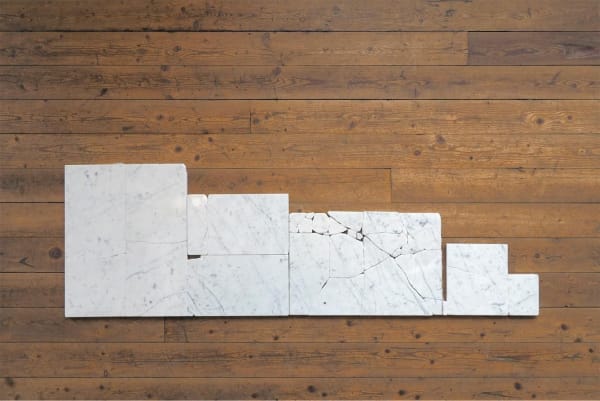Aspirational Architectures: Curated by Justine Ludwig
-
Aspirational Architectures explores the aims and failures of architecture to form ideal communities and futures. It addresses how built space speaks to human need and desire for a better life, individually and collectively. Featuring the work of artists Tanya Goel, Yamini Nayar, Laercio Redondo, and Lucia Simek, this exhibition draws from unique experiences, source material, and geographies in order to present an intimate perspective on the subject matter.
Tanya Goel's fresco architectural fragments speak to the rapidly changing urban landscape of her native New Delhi. She is interested in the surfaces that make up quotidian existence-roads, buildings, and sidewalks. She attends to these urban fragments like an archivist. Many of the pigments Goel uses are collected from demolished modernist houses that were originally built in the 1950s in Delhi. Charcoal, aluminum, concrete, glass, soil, mica, and graphite come together to make iridescent otherworldly tonalities. The works speak to the need for a newly envisioned future constructed from the remnants of the past.
Laercio Redondo addresses global architectural realities and their utopic aims. In his video installation Abstraction Lies Redondo takes the architectural design of the iconic National Congress Palace in the federal capital of Brazil, Brasília, as a starting point. The building is reproduced in the installation via the shadows of Bauhaus Bauspiel toy blocks against the projection of a turbulent sky. The iconic silhouette of the National Congress Palace, designed by architect Oscar Niemeyer, is regarded as the main symbol of the capital of Brazil. When the city was planned, it was intended to herald a new era of rationality, leading the country into modernity. The projected image, and the blocks casting the shadows within it, form a contradiction between ideal and reality. They allude to the challenges and pitfalls of modern utopic aspirations.
Yamini Nayar's constructed photographs address the psychological ramifications of built space. Fractured and labyrinthine, they speak to the relationship between memory and architecture while establishing a tension between the remembered and the real. Nayar constructs these spaces in her studio, photographs them, and then discards the construction, leaving only the documented image. The result is a photograph of psychological space, a topography of the mind itself.
In her sculptures, Lucia Simek addresses specific structures in the context of her personal experience. "Is this ambition?" (The Beginnings of a Hut) began as an architectural model based on the ice hut designs of Salomon August Andrée, who led an unsuccessful balloon expedition to the North Pole. Andrée died en route and never saw his structure built. Similarly, Simek's model for Andrée's shelter was shattered on its way to be shown in Iceland. The poetic nature of this destruction was not lost on the artist. The broken slabs were transformed into a new work-each piece neatly placed on the ground next to each other, spurring conversation around one's aspirations and the possibilities born from failure.
Aspirational Architectures is devoid of human presence. It speaks to the dreams and failures of human aspiration and the investigation of the spaces we occupy and how they form our reality. As a whole, the works address the power of architecture both realized and imagined.
-
Press

